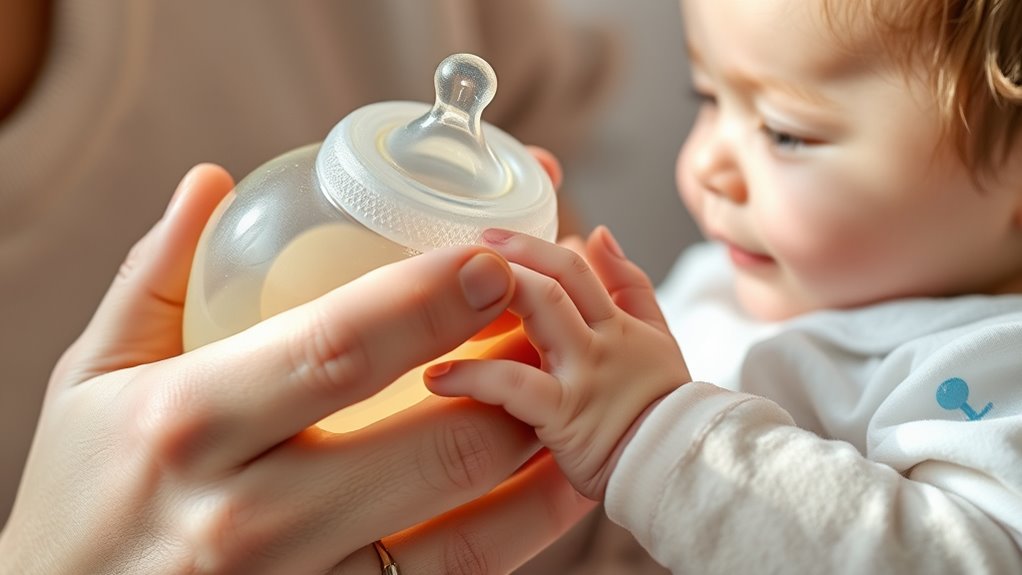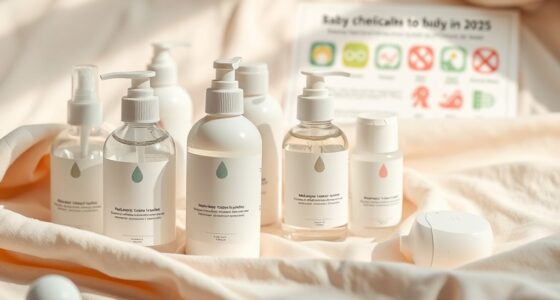Paced bottle feeding mimics breastfeeding by helping your baby regulate intake, control milk flow, and recognize fullness cues. To do this, hold your baby semi-upright, tilt the bottle to fill the nipple, and let them pause and take breaks as needed. Watch for signs of hunger and fullness to prevent overfeeding. Using the right bottle and nipple can make this easier. Keep exploring to get more helpful tips for a comfortable, responsive feeding experience.
Key Takeaways
- Hold the baby upright and support their head to simulate breastfeeding position.
- Tilt the bottle slightly to fill the nipple and prevent air swallowing.
- Allow the baby to control the flow by pausing and taking breaks as cues indicate fullness or interest.
- Use slow-flow, wide, and natural-shaped nipples to mimic breastfeeding and promote pacing.
- Watch for hunger and fullness cues, responding calmly to ensure a comfortable, responsive feeding experience.
Understanding the Basics of Paced Bottle Feeding

Paced bottle feeding is a technique that mimics breastfeeding, helping your baby regulate their intake and develop healthy feeding habits. To do this, hold your baby in an upright position, supporting their head, and use a slow-flow nipple. Let your baby take the lead by observing their sucking rhythm and pauses. When they stop sucking or slow down, gently remove the bottle to prevent overfeeding. It’s important to avoid forcing the milk, allowing your baby to control the flow. Keep the feeding relaxed and responsive, paying attention to cues like turning away or slowing down. This method encourages your baby to self-regulate, making feeding more comfortable for both of you and supporting their natural feeding instincts. Proper feeding techniques can also promote a positive feeding experience and help foster healthy eating habits early on.
Benefits of Using the Paced Feeding Method

Using the paced feeding method offers numerous benefits for both you and your baby. It helps prevent overfeeding by allowing your baby to control the flow and pace, reducing the risk of spit-up and discomfort. This technique encourages your baby to maintain a natural sucking rhythm, promoting better digestion and reducing fussiness later. It also supports your baby’s self-regulation skills, helping them recognize their hunger and fullness cues. For you, paced feeding can make feeding times more relaxed and manageable, decreasing the likelihood of choking or gagging. Additionally, it fosters bonding by promoting eye contact and interaction during feeds. Incorporating proper projector calibration techniques can further enhance your baby’s visual engagement during feeding routines. Overall, this method nurtures your baby’s healthy feeding habits while making the experience more comfortable and enjoyable for both of you.
Preparing for a Paced Bottle Feeding Session

Before starting a paced bottle feeding, gather all the supplies you’ll need, like a clean bottle, nipple, and any comfort items. Choose a quiet, comfortable environment where both you and your baby can focus without distractions. Being prepared helps make the feeding session smooth and relaxing for everyone involved. Additionally, ensuring the proper usage of the bottle can help facilitate an effective feeding experience.
Gather Necessary Supplies
Are you prepared to guarantee a smooth feeding session? First, gather everything you’ll need: a clean bottle with a slow-flow nipple, a cloth or bib to catch dribbles, and a small cup of water if necessary. Make sure the bottle and nipple are sterilized and ready to go. Have a clean towel nearby for cleaning up spills or wiping your baby’s mouth. If you’re using formula, measure and prepare it in advance to avoid delays. Keep everything within arm’s reach so you’re not searching during feeding. Double-check that the bottle is at the right temperature—lukewarm, not hot. Preparing these supplies beforehand allows you to focus on your baby, ensuring a calm, unhurried feeding experience. Additionally, understanding the importance of spiritual energy can help foster a peaceful environment during feeding, promoting emotional connection and overall well-being.
Choose Comfortable Environment
Creating a comfortable environment sets the tone for a peaceful, paced bottle feeding. Find a quiet, cozy space free from distractions, where your baby feels secure. Dim the lights if needed and keep the room at a comfortable temperature. Use a supportive chair or nursing pillow to hold your baby upright, which helps prevent choking and makes feeding easier. Minimize noise and interruptions so you can focus on your baby’s cues. Have all supplies within reach to avoid getting up during the feeding. A calm, relaxed setting encourages your baby to feed at a natural pace, making the experience more enjoyable for both of you. Remember, creating a peaceful environment helps your baby feel safe and promotes better feeding habits. Additionally, understanding feeding environment can further enhance your baby’s comfort and the success of the feeding session.
Recognizing Baby’s Hunger and Fullness Cues

To feed your baby effectively, you need to recognize their hunger and fullness cues. Look for signs like rooting or lip smacking when they’re hungry, and turn-away or relaxed hands when they’re full. Paying attention to timing and establishing a routine can also help you better understand your baby’s needs. Incorporating awareness of hunger cues can further refine your feeding approach.
Signs of Hunger
How can you tell when your baby is hungry or full? Recognizing hunger cues helps you respond promptly and comfortably. Look for signs like rooting, sucking on fists, or becoming alert and restless. If your baby starts to turn away from the bottle or slows sucking, they may be full. Paying attention to these cues guarantees a positive feeding experience. Additionally, observing nail styles names such as rounded or square shapes can reflect your baby’s overall comfort and health during feeding times.
Indicators of Fullness
Recognizing when your baby is full is just as important as noticing hunger cues, as overfeeding can cause discomfort. To identify fullness, watch for these signs:
- Slowing or stopping sucking – Your baby may lose interest and stop actively sucking.
- Turning away from the bottle – They might push the bottle away or shift their head.
- Relaxed hands and body – Their hands will relax, and they’ll appear calm or sleepy.
- Decreased swallowing – Swallowing diminishes notably or stops altogether.
If you notice these cues, it’s best to gently remove the bottle to avoid overfeeding. Paying attention helps your baby learn to self-regulate intake and ensures feeding remains comfortable and effective.
Timing and Routine
Understanding your baby’s hunger and fullness cues requires paying close attention to timing and establishing a consistent routine. By feeding your baby at regular intervals, you help them develop predictable hunger patterns, making it easier to recognize when they’re genuinely hungry or full. Watch for early cues, like rooting or lip smacking, so you can offer the bottle before they become overly distressed. Consistent routines create a sense of security and help your baby learn when to expect feeds. Avoid waiting until they cry or show intense hunger signs, as this can lead to overeating or frustration. Regularly assessing your baby’s cues and zone creation can help you fine-tune your approach to feeding times. Over time, your baby will become more attuned to their own hunger and fullness cues, making feeding sessions more comfortable and effective for both of you.
Step-by-Step Guide to Performing Paced Bottle Feeding

Paced bottle feeding is a gentle technique that helps simulate breastfeeding and promotes better self-regulation for your baby. To perform it effectively, follow these steps:
- Hold your baby in an upright position, supporting their head and neck comfortably.
- Tilt the bottle slightly so the nipple is filled with milk, preventing air intake.
- Let your baby control the flow by pausing and taking breaks, mimicking a nursing rhythm.
- Watch for signs of fullness, like slowing down or turning away, and stop feeding when they show these cues.
- Understanding the importance of feeding cues can help you respond appropriately and ensure a positive feeding experience.
This method encourages your baby to regulate their intake while preventing overfeeding. Stay attentive to their responses throughout the process to ensure a calm, comfortable feeding experience.
Tips for a Comfortable and Successful Feeding Experience

Creating a comfortable and successful feeding experience starts with preparing a quiet, cozy environment where your baby feels safe and relaxed. Keep the room dimly lit and minimize noise to help your baby stay calm. Hold your baby in a semi-upright position, supporting their head and neck comfortably. Use a slow-flow nipple to regulate the flow and prevent choking or frustration. Take breaks if your baby seems overwhelmed or tired, allowing them to rest or burp. Be attentive to your baby’s cues, such as turning away or losing interest, and respond calmly. Maintain eye contact and speak softly to foster bonding. Ensuring a peaceful atmosphere and attentive care helps your baby feed comfortably and builds a positive feeding routine. Incorporating calm and comfortable environments can positively influence your baby’s feeding experience.
Common Challenges and How to Overcome Them

Even with a prepared and calm environment, many parents encounter common challenges during feeding. One issue is the baby swallowing air, which can cause discomfort. To prevent this, guarantee the bottle is at the right angle and the nipple is full of milk. Second, some babies may refuse the bottle altogether. Try adjusting the feeding position or offering the bottle when your baby is less hungry. Third, pacing can be difficult if the baby becomes too frantic or sluggish. Watch for cues and pause if needed to maintain a steady flow. Finally, frustration might set in if the baby gets overwhelmed. Stay patient, keep the environment calm, and take breaks to help your baby stay comfortable and engaged throughout feeding.
Choosing the Right Bottle and Nipple for Paced Feeding

Choosing the right bottle and nipple is essential to guarantee smooth and comfortable paced feeding for your baby. Look for bottles with wide, slow-flow nipples that mimic breastfeeding and help control the flow of milk. The nipple’s shape should resemble a natural breast to encourage a good latch and reduce nipple confusion. Adjustable flow options are beneficial, allowing you to slow or speed the flow as needed. Soft, flexible nipples with venting or anti-colic features help minimize air intake, reducing discomfort and gas. Ensure the bottle is easy to hold and clean, making feeding less stressful for both of you. Selecting the right combination helps your baby feed comfortably at your pace, making the experience more natural and less frustrating.
Integrating Paced Bottle Feeding With Breastfeeding

You can smoothly combine paced bottle feeding with breastfeeding by using a synchronized approach that respects your baby’s cues. This method helps maintain the core breastfeeding behaviors while introducing bottle feeds. By balancing both, you support your baby’s feeding needs without disrupting their natural feeding rhythm.
Synchronized Feeding Approach
The Synchronized Feeding Approach combines paced bottle feeding with breastfeeding to promote a seamless and comfortable feeding experience for both mother and baby. This method helps prevent nipple confusion and supports your baby’s natural feeding cues. To implement it:
- Offer the bottle when your baby shows hunger cues, not on a schedule.
- Keep the bottle at a slight angle, allowing your baby to control the flow.
- Mimic breastfeeding by pausing during feeding to let your baby rest or burp.
- Watch for signs of satiety, stopping when your baby releases or slows down.
Maintaining Breastfeeding Cores
Maintaining breastfeeding cores while incorporating paced bottle feeding helps safeguard your baby’s natural feeding patterns and guarantees consistency. Focus on keeping the feeding environment calm and comfortable, just like during breastfeeding. Use slow, gentle bottle flows to mimic the baby’s sucking rhythm, and let your baby set the pace. Watch for cues that indicate when they’re full or need a break, such as turning away or slowing down. Keep the baby upright during feeding to prevent choking and promote proper digestion. Avoid rushing or forcing the bottle, as this can disrupt your baby’s natural cues. By respecting your baby’s feeding rhythm and maintaining familiar routines, you help preserve the breastfeeding core, making the transition to bottle feeding smoother while supporting their developmental needs.
Monitoring Baby’s Development and Feeding Satisfaction

Monitoring your baby’s development and feeding satisfaction is essential to guarantee they’re growing healthily and comfortably. Pay close attention to these key signs:
- Weight gain: Regularly check your baby’s weight to ensure steady growth.
- Feeding cues: Notice when your baby shows signs of hunger or fullness, like rooting or turning away.
- Satisfaction: Observe if your baby appears content after feeds and seems relaxed.
- Behavioral changes: Watch for signs of discomfort, fussiness, or sleep disturbances, which could indicate feeding issues.
Frequently Asked Questions
Can Paced Bottle Feeding Help Reduce Overfeeding Risks?
You’re wondering if paced bottle feeding can lower overfeeding risks. It definitely can. By paying attention to your baby’s cues and giving them breaks during feeding, you help prevent them from consuming too much too fast. This technique encourages a natural feeding pace, similar to breastfeeding, so your baby can regulate their intake better. As a result, you reduce the chances of overfeeding, making feeding safer and more comfortable for your little one.
Is Paced Bottle Feeding Suitable for Premature Babies?
Think of a gentle stream guiding a delicate leaf, much like how paced bottle feeding gently supports premature babies. It’s suitable because it mimics breastfeeding, helping regulate their intake and breathing. You can use this method to prevent overfeeding and promote healthier weight gain. By pacing feeds, you respect your baby’s cues, making feeding a nurturing experience that fosters development and comfort, especially for those born early.
How Do I Transition From Bottle to Breastfeeding Using This Technique?
You want to shift from bottle to breastfeeding smoothly. Start by offering your baby the breast more often, using paced feeding techniques to mimic natural feeding. Pay attention to your baby’s hunger cues and let them set the pace. Keep the environment calm, hold them close, and guarantee a comfortable latch. Over time, as your baby becomes more confident, they’ll prefer breastfeeding, making the switch easier for both of you.
What Signs Indicate My Baby Is Tired During Feeding?
Ever wonder how to tell when your baby is tired during feeding? You’ll notice signs like slowing down, losing interest, or becoming less active. They might start to doze or turn away from the bottle. These cues show they’re ready to rest. Paying attention helps you know when to pause, ensuring your baby stays comfortable and engaged, making feeding a more positive experience for both of you.
Are There Age Restrictions for Practicing Paced Bottle Feeding?
You wonder if there are age restrictions for practicing paced bottle feeding. Generally, it’s suitable for babies of all ages, including newborns and older infants, because it mimics breastfeeding and promotes healthy feeding habits. However, consult your pediatrician if your baby has specific health concerns. As long as your baby shows readiness and you’re attentive to their cues, paced bottle feeding can be safely practiced at any age.
Conclusion
By mastering paced bottle feeding, you can help your baby feed more comfortably and develop healthy eating habits. Studies show that babies fed using this method tend to self-regulate intake better, reducing overfeeding risks. Remember to stay attentive to your little one’s cues and choose the right bottle and nipple. With patience and practice, you’ll strengthen your feeding routine and support your baby’s growth and satisfaction at every meal.









